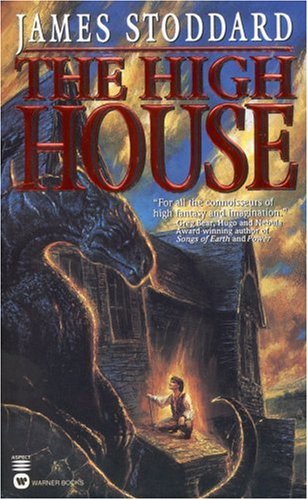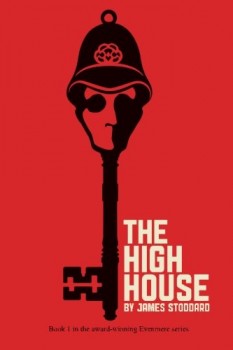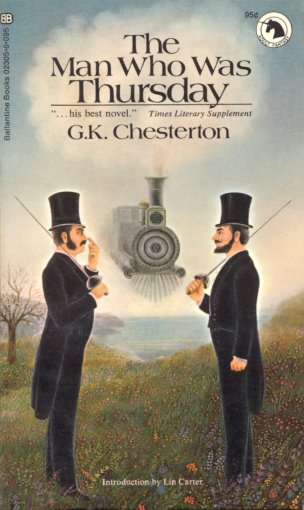The High House by James Stoddard
 I need to find some new superlatives for the books I read. Too often I fall back on “terrific” or “awesome” or just plain “great.” Those are all stalwart words, but after I’ve described two or three books with them, it just seems lazy to describe the next two or three with the same exact words. I do it to make clear I liked a particular book and that I think it’s worth Black Gate readers’ attention, but it’s really lazy of me to just keep using the same superlatives again and again. That said, James Stoddard’s The High House (1998) is exceptional, superb, and top-notch.
I need to find some new superlatives for the books I read. Too often I fall back on “terrific” or “awesome” or just plain “great.” Those are all stalwart words, but after I’ve described two or three books with them, it just seems lazy to describe the next two or three with the same exact words. I do it to make clear I liked a particular book and that I think it’s worth Black Gate readers’ attention, but it’s really lazy of me to just keep using the same superlatives again and again. That said, James Stoddard’s The High House (1998) is exceptional, superb, and top-notch.
The High House of Evenmere is
a truly beautiful pile of building, all masonry, oak, and deep golden brick, a unique blend of styles — Elizabethan and Jacobean fused with Baroque — an irregular jumble balancing the heavy spired tower and main living quarters on the western side with the long span flowing to the graceful L of the servants’ block to the east. Innumerable windows, parapets, and protrusions clustered like happy children, showing in their diversity the mark of countless renovations. Upon the balustrades and turrets stood carved lions, knights, gnomes, and pinecones; iron crows faced outward at the four corners. The Elizabethan entrance, the centerpiece of the manor, was framed by gargantuan gate piers and pavilions, combining Baroque outlines with Jacobean ornamentation.
The building “is the mechanism that propels the universe, (. . .) If the Towers’ clocks are not wound their portion of Creation will fall to Entropy.”
Lord Ashton Anderson is responsible for protecting the High House. The foremost enemy of the house is the Society of Anarchists, led in the field by the Bobby, a man dressed in the uniform of a police constable and with a face from which the features sometimes vanish, leaving him looking like a “faceless doll.”
The story, though, is not Lord Anderson’s, but his son Carter’s. When Carter is nearly killed and the Bobby steals the Master Keys, Lord Anderson sends his son away for safety. Carter doesn’t return for fourteen years, during which time his father vanished while on expedition in the land of the Tigers of Naleewuath.
By the time Carter comes home the House, without a Master for many years, is at great risk from the Anarchists. Armed with the Master Keys, they have opened secret ways to let themselves in to previously inviolable places and locked long-used doors. The House demands a Master and it quickly becomes clear that Carter has been chosen as a candidate.
 If it’s not obvious from the names of the characters and the description of the High House and its enemies, Stoddard’s book is an ode to pre-genrefied fantasy of the sort editor Lin Carter returned to the public eye with the Ballantine Adult Fantasy series in the late 1960s and early 70s. Character names are borrowed from past fantasy writers or their creations, and they read books by H. Rider Haggard and William Morris. Lines of poetry from Robert Louis Stevenson and Alfred Lord Tennyson appear throughout the book. The High House’s convoluted corridors, idiosyncratic rooms, and especially its tower- and spire-festooned roof, echo loudly of Mervyn Peake’s fictional castle, Gormenghast. The Anarchists as enemy, as well as some of the book’s Christian elements, could have leaped from the pages of G. K. Chesterton’s, The Man Who Was Thursday.
If it’s not obvious from the names of the characters and the description of the High House and its enemies, Stoddard’s book is an ode to pre-genrefied fantasy of the sort editor Lin Carter returned to the public eye with the Ballantine Adult Fantasy series in the late 1960s and early 70s. Character names are borrowed from past fantasy writers or their creations, and they read books by H. Rider Haggard and William Morris. Lines of poetry from Robert Louis Stevenson and Alfred Lord Tennyson appear throughout the book. The High House’s convoluted corridors, idiosyncratic rooms, and especially its tower- and spire-festooned roof, echo loudly of Mervyn Peake’s fictional castle, Gormenghast. The Anarchists as enemy, as well as some of the book’s Christian elements, could have leaped from the pages of G. K. Chesterton’s, The Man Who Was Thursday.
Carter’s journey, through the secret passages of the High House and among the lands of the White Circle, is one of discovery; of the mysterious world his father inhabited, the true nature of the High House, and of his own maturity into a man of great responsibilities. Burdened by ignorance, and lacking the weapon and garb of his father — the jagged Lightning Sword and the Tawny Mantle — Carter’s attempts to thwart the Anarchists are opposed with great tenacity each step of the way. There is much action and danger, presented by Stoddard with great vim and vigor. Allies, both expected and unexpected, join Carter at times, easing his struggle, but in the end, he must draw deeply from inside himself and become the man with the strength to save the High House.
As should be obvious, the High House is not a simple mansion. In addition to a fairly normal and standard assortment of rooms, there are staircases and hallways that don’t always stay in the same places. The attic, a space of shifting location and dimensions, is the lair of a great monster.
“I am Jormungand, the Last Dinosaur, destroyer, devourer, ravager of kingdoms and epochs, all greed and covetousness, brooding loneliness. Once I was Dragon, but in this scientific age that is no longer stylish. The flames I kept for high drama. Now I, who was once Behemoth, am only pieced-together bones, first believed to belong to biblical giants, fresh-dug by nearsighted archaeologists, given flesh by faint intellects, made poorer by lack of imagination.”
 The House’s Long Corridor leads not to other rooms of the High House, but to other lands, some fully confined to halls and chambers, sometimes with streams flowing through them, other times with fields and forests rising up from some seemingly impossible landscape. Stoddard gives wonderful detail to each of the lands and its inhabitants. Every surface, every thing, in one land usurped by the Anarchists, has been painted brown. The food, all brown now, is, of course, tasteless, the water brackish. In another, where the king died in combat with a beast unleashed by the Anarchists, the land is run by the Guild of Burnishers. The guild exists to maintain and polish the land’s great expanse of oaken corridors and carvings. Another land is beset by man-eating creatures that disguise themselves as furniture.
The House’s Long Corridor leads not to other rooms of the High House, but to other lands, some fully confined to halls and chambers, sometimes with streams flowing through them, other times with fields and forests rising up from some seemingly impossible landscape. Stoddard gives wonderful detail to each of the lands and its inhabitants. Every surface, every thing, in one land usurped by the Anarchists, has been painted brown. The food, all brown now, is, of course, tasteless, the water brackish. In another, where the king died in combat with a beast unleashed by the Anarchists, the land is run by the Guild of Burnishers. The guild exists to maintain and polish the land’s great expanse of oaken corridors and carvings. Another land is beset by man-eating creatures that disguise themselves as furniture.
One of the problems with genre fiction is that no matter how expansive a genre is, there are still limitations to how far it can stray from the paddock. Epic fantasy, with its hidden heirs, magic rings, doughty dwarfs and brooding barbarians, has an endless list of tropes and cliches, and no matter how unique a work strives to be, some find their way in. Even grimdark fantasy, a genre that has evolved as a deliberate critique of the tropiest epic fantasy, is already drafting its own collection of tropes: anti-heroes, graphic violence, cynicism, amoral settings. Before the works of Tolkien and Howard were taken as a set of templates for how to tell stories instead of inspiration for telling wholly new ones, fantasy existed as a great, differentiated library of stories with little to mark them as related save an element of the mythical or supernatural. Reading genre fiction every week, week after week after week, can become numbing. Stoddard’s marvelous book exists as a testament to what fantasy can be outside of its usual narrow confines. I recommend this book without reservation. It and its two sequels — The False House (1999) and Evenmere (2015) are all available as affordable e-books. I will be reading the rest of the series this year.
I don’t know if they remember, but several years ago Keith West and Howard Andrew Jones made a strong case for The High House on Howard’s website. Not long after, I tracked down Stoddard’s site and discovered he was in the process of having it, and the first sequel, released as e-books. As they were fairly inexpensive, I snatched them up at once. When the third book was released, I bought that as well. That was two-and-a-half years ago and, as it is with many of the books on which I spend good money, they sat on their digital shelf unread since then. Until this past week. I’m really glad that changed.
Bonus: One industrious individual by the name of GARYT23 undertook to ascertain the derivation of all the allusions and references contained with The High House and collected them here.
Fletcher Vredenburgh reviews here at Black Gate most Tuesday mornings and at his own site, Stuff I Like when his muse hits him. Right now, he’s writing about nothing in particular, but he might be writing about swords & sorcery again any day now.
Lovely! I wanna read this right now! Superlative write-up, Fletcher. I’ll be adding this to my reading list…that has 38 currently reading titles…
Ah, man, I want a copy with your cool cover at the opening, not that yucky thing they’re using for the series now.
That’s one of the real challenges with self-publishing, especially niche and/or rescued back catalog titles — the author probably won’t have the budget to license, say, a Bob Eggleston painting for the rerelease.
Jason — fortunately for collectors, not a lot of folks know about this book. Which means the Warner Aspect paperback is still available through online sellers for rock-bottom prices, despite being out of print for two decades. eBay currently has 4 copies priced at under four bucks, including shipping:
https://www.ebay.com/sch/i.html?_from=R40&_trksid=p2486671.m570.l1313.TR0.TRC0.H0.X%22high+house%22+james+stoddard.TRS0&_nkw=%22high+house%22+james+stoddard&_sacat=0
…except if you buy an old one, the talented James Stoddard gets no money.
And he needs our support, because the guy is gifted. I LOVE this book. I’m looking forward to publishing some of his short stories in Tales From the Magician’s Skull.
Thanks John! And you are correct, Howard. That is quite the regular conundrum – having to choose between buying cool old paperbacks with inspiring artwork that can be seen on one shelves but are used and generate no income to the deserving authors, or purchasing cold, digital files with less compelling covers that no one will ever even notice on imaginary shelves tucked away in never-never land yet send needed monies to the creators. Regretfully, I typically will go for the physical beauty that my children-grandchildren and friends can see, hold, and spark conversation with.
When I discuss this book, one of the things I say to recommend it — I mean in addition to its amazing prose and profound imagination — is that it is more what I imagined Gormenghast would be, but wasn’t.
The other is that it’s one of the few books I know about a young man becoming a mature man. Not a boy growing into a man, or even a sort of immature person growing up, because Carter is a mature person when the tale starts. He’s certainly no callow youth.
Yet he has to come to grip with his own failings and his own strengths, understand the loss of a parent, and who that parent really was, struggle to relate to another sibling/rival brother, and all sorts of more realistic things that just aren’t usually handled in a genre work like this.
Some have criticized it because there are few important female characters. Just because something’s true doesn’t mean it’s an appropriate criticism. I happen to think that until recently there were very few important female characters in genre lit. But female characters aren’t what this book is about, and that should be okay. Not every book can be about every issue. It happens to address another rarity, which is how a decent man grows in responsibility and a greater understanding of the world around him, sometimes painfully. It affected me deeply. It’s full of scenes of fantastic power. It’s far and away one of the finest fantasy novels I have EVER read and it’s criminal that so few have heard of it.
@Jason – Saw you bought it (before the FB post was deleted by the admin I guess). I’m looking forward to what you think of it. I like the new covers’ clean graphic designs myself.
@Joe H – yeah, which I guess explains the misbegotten covers of a lot of e-book reprints (looking straight at you, Horseclans books)
@Howard – Thank you so much for recommending and this book. It indeed warrants far more recognition and a wider readership than it has, though from some of the comments on FB, it’s clearly a very much loved book by a lot of people whose taste I respect.
I agree with you regarding books not needing to be for everyone. What’s important for me is that a book tells the story the author intends it to.
I’m looking forward to the 2 sequels with great anticipation.
Those Horseclans covers violate the Geneva Conventions.
One of my favorites!
And if you like Stoddard, AND you’ve always been intrigued by the sheer awe that William Hope Hodgson’s THE NIGHT LAND is held in but can’t get past the strange pseudo-archaic prose style, check out Stoddard’s retelling: THE NIGHT LAND, A STORY RETOLD. Although I could not get into the original myself, I read Stoddard’s treatment and I GOT IT. That is, I think Stoddard’s interpretation must have been successful because I came away just in utter awe and wonder at what Hodgson’s imagination had wrought.
Thanks for reviewing this. It and Stoddard’s retelling of The Night Land are both high on my to-read list.
@nick I need to include a link to your interview with Stoddard. I’m tempted to read his The Night Land ecause I couldn’t make it very far in the original. What’s held me back is I feel like if I admit being defeated by the original it’s some sort of reader moral failing.
@Raphael I really think you’ll dig it
@ Fletcher:
” I like the new covers’ clean graphic designs myself.”
Really? That surprised me! Not so much you liking this particular design (everyone has different reactions, though it actually turns me away), but with all your reviewing of pulpish heroic adventure I would think your art tastes would be equally larger-than-life. Hmm, very interesting. 🙂
Hah! Jeff Jones and Frank Frazetta are definitely on my list of favorite cover artists, but this book calls for something like Gervasio Gallardo’s art for the BAF. The original cover feels not right to me.
When Nick and I were publishing our own magazine, when this book came out, we loved it so much that we bought copies every time we went to Barnes & Noble. We handed them out to our friends.
Cool if yous guys!
FYI, Received my copy today! Great shape – except for the $&$+-&?!;;#@@## indestructible barcode sticker right in the middle of the front cover! I really, really despise sellers who do this, grrr!